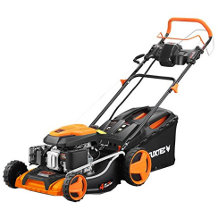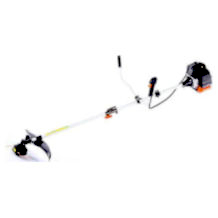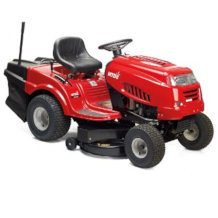Lawn scarifier purchasing advice: how to choose the right product
- The most important facts in brief
- A scarifier is a device that cuts only a few millimetres into the lawn. In this way it removes moss and weeds, but not the blades of grass.
- The quality of the rotating blades is crucial for successful treatment of the lawn.
- Moss and weeds hinder the water and nutrient supply of the lawn.
- Treatment with the scarifier thus revives the growth of the lawn.
Lawn care with the scarifier
Because the lawn makes up the majority of a garden area, it should be beautifully green and healthy. Mowing the lawn alone is not enough to achieve this. The so-called scarifying – the scratching of the lawn – is an important part of lawn care. The device designed for this purpose is called a scarifier. It maintains the lawn in two ways: Firstly, it removes lawn thatch, moss and unwanted plants that rob the grass of nutrients in the soil with its rotating blades. This is an important prerequisite for young blades of grass to grow back. Secondly, the scarifier scores the turf with its blades and promotes the growth of the blades of grass through these small injuries. The simultaneous “de-aeration” of the lawn allows nutrients to circulate more freely again. In this way, scarifying ensures a dense, resistant lawn. Well-known manufacturers of these tools are Einhell, Wolf Garten, Makita and Bosch.
With vertical cuts to a healthy lawn
A scarifier is equipped with sharp, pointed blades. Visually, it could be mistaken for a lawn mower, but the way it works is fundamentally different. While the blades of a lawn mower rotate horizontally over the lawn, the blades of a scarifier cut vertically into the ground. The method of operation also gives the device its name. It is made up of the words vertical and to cut. If the scarifier is used correctly, the result is impressive. After a few weeks, garden owners can look forward to lush green and weed-free lawns.
At the latest when so-called lawn felt has formed on the grass surface, the scarifier comes into play. Lawn thatch is a layer of moss and old cuttings that have been left lying around. This layer not only impedes the exchange of air, but also the supply of water and nutrients to the grass roots. As a result, the roots flatten, mosses and other undesirable plants spread. Areas that spend a lot of time in the shade are particularly susceptible to lawn thatch. You can tell whether the lawn is affected at the latest when green-brown spots have formed on it. Before that, there is a simple trick to determine whether lawn thatch is present: pull a rake over the ground without applying much pressure. If moss and clippings stick to it, consider a round with the scarifier.
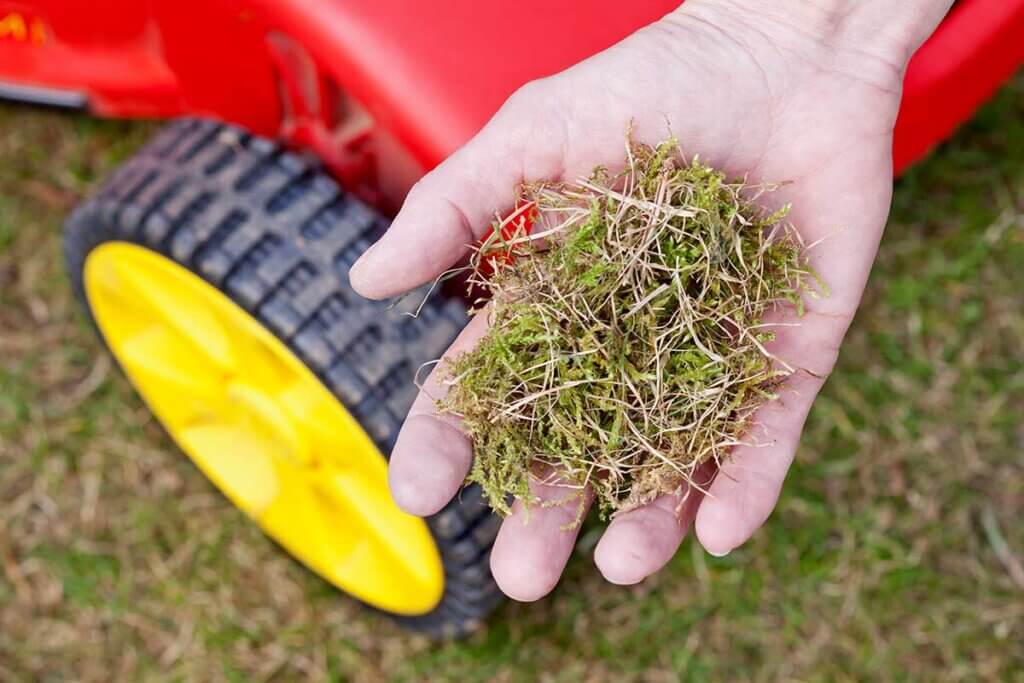
In principle, however, scarifying is not a job that has to be done. A lawn is a monoculture of grass blades that, without care, has no chance against the spread of other plants. If you like a wilder garden, you can safely do without a scarifier and use a rake instead. However, if you want to have a particularly tidy lawn without foreign growth, there is no getting around scarifying.
Where does lawn felt come from?
Felt occurs when the microorganisms in the soil no longer work properly due to a lack of nutrients. Dead plants and cuttings that have been left lying around are then no longer decomposed by them. After a while, a felt-like layer forms on the lawn.
How does a scarifier work?
A scarifier is a simple device. It has two or four wheels and is pushed over the lawn like a lawn mower. With its rotating steel blades, it cuts vertically only a few millimetres into the ground. The blades either sit on the front axle and rotate as soon as the device is set in motion, or they are powered by a motor. Due to the low cutting depth, the scarifier removes moss and weeds without damaging the turf. This is because these usually have a shallower root depth than lawns. If the scarifier is set correctly, it only pulls out moss and weeds. The removed plants – if present – end up in a catch basket or on the lawn. In the second case, they must be removed with a rake after scarifying. In a larger garden, this is a tedious and strenuous task.
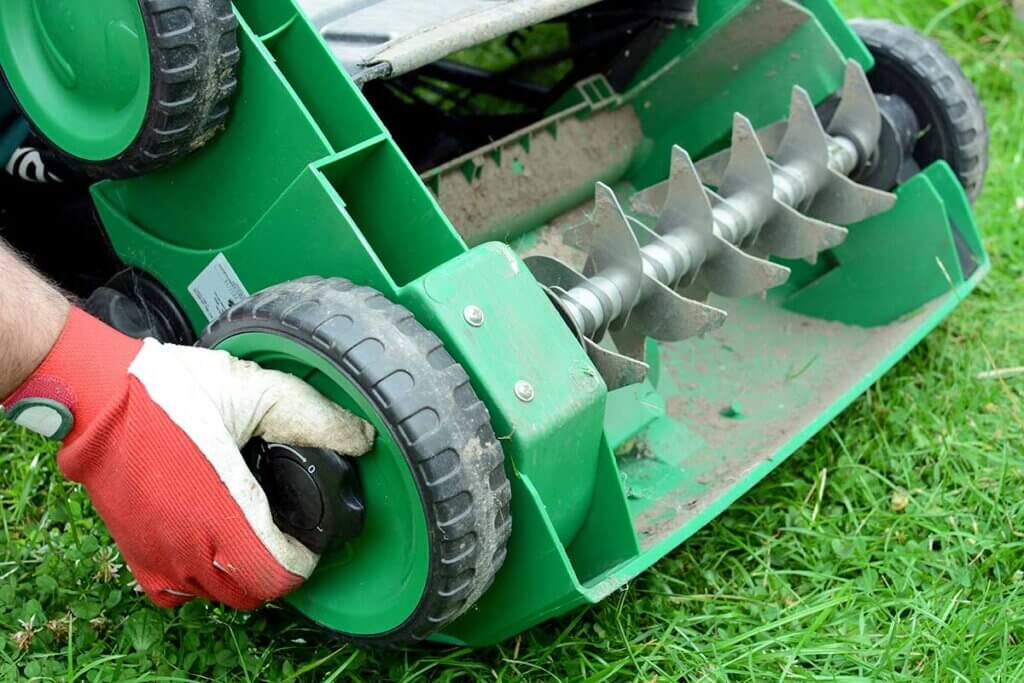
Different scarifier models
Scarifiers fall into three different categories: manual, electric and petrol-powered. Depending on the size of the garden and the desired application, a specific scarifier model is recommended.
Manual scarifier
The manual scarifier is the simplest model. The blades are attached to the axle of the wheels and start rotating as soon as the scarifier is pushed. A telescopic pole is provided for handling the device. Manual scarifiers are well suited for small gardens. They do not need electricity or petrol and are therefore the most environmentally friendly option. The noise level during use is also extremely low. However, a certain amount of force is to be expected when using the manual device. It is therefore not for people for whom gardening should be as comfortable as possible. However, this will not deter people who appreciate physical activity.
Pro points
- Requires no power source
- Almost noiseless
- Inexpensive purchase
Drawbacks
- High effort
- Time-consuming
- No collection basket
Electric scarifier
The electric scarifier is equipped with an electric motor that drives the blade shaft. Muscle power is only required to push the device. For most gardens, such a model is quite sufficient. For large gardens, from an area of 600 square metres, handling can be difficult because of the cable. A cable drum can help out here. An alternative is a battery-powered scarifier, but this usually offers somewhat less power than models that are connected to the mains. However, battery-powered models are not suitable for continuous operation on larger lawns. Electric scarifiers are ideal for more densely built-up neighbourhoods, as they do not disturb residents with emissions or excessive noise levels.
Pro points
- Low-noise use
- No direct emissions
- Moderate price
- Easy maintenance
Drawbacks
- Cable tie
Petrol-powered scarifier
Buying a petrol-powered scarifier makes sense if you have a very large garden or want to use the machine commercially. Petrol-powered models offer the most power and are independent of power cables, which is particularly important for large areas. This is the quickest way to get the job done. However, a petrol scarifier is considerably heavier than the other models and is quite noisy during operation. Because of the exhaust fumes it produces, it is anything but environmentally friendly. The person operating the scarifier is also exposed to the exhaust fumes. Therefore, such a model should only be used if the operation of an electric scarifier is really out of the question.
Pro points
- Greater freedom of movement
- Powerful
- Suitable for large areas
- Less time required
Drawbacks
- High volume
- High weight
- Harmful to environment and health
- Expensive
What is the difference between scarifiers and lawn aerators?
The terms lawn aerator and scarifier are often used synonymously. For this reason, it is easy to make a wrong purchase. A lawn aerator does not scarify the soil, but merely combs through the lawn and removes the felt. The lawn aerator therefore performs the task of a garden rake. Whether a device is a scarifier or a lawn aerator can be easily recognised by the roller. There are no blades on the lawn aerator, but discs or spring tines.
How to find the right scarifier
The most important component of a scarifier is the rotating blades. When buying a lawn scarifier, therefore, two aspects are crucial: the motor power and the quality of the blades. If these two aspects are not right, the scarifier will ruin the lawn instead of maintaining it.
Power
Sufficient power is needed for an optimal result of scarifying. The power required depends on the size of the garden. How much power the scarifier can produce is determined by how fast the blade shaft rotates. A high number of revolutions makes the work easier, but too much power can also damage the lawn. At best, the speed should be adjustable on the device. For very large areas, a petrol-powered scarifier with a 4-stroke engine and a power output of between three and four hp is recommended.
Blade roller
The core of a scarifier is the roller on which the blades are located. Basically, the smaller the distances between the blades, the more effectively the machine works. A larger number of blades is also helpful. A normal scarifier has at least ten blades on a width of 30 centimetres. Up to 20 blades are common. However, a high number of blades does not necessarily ensure a better result. A good shape and workmanship of the blades is essential.
Not all rollers are the same. If the blades are suspended so that they can move, the machine is less prone to clogging. This makes the work much easier. This type of suspension also keeps the blades clean longer. With good machines, the scarifying roller can be replaced with simple tools or even without tools. Special rollers can then be used to extend the scarifier’s range of functions.
Safety first
You should exercise absolute caution with fast rotating blades! Wear very sturdy footwear – safety shoes, for example – and put on ear protection. The lawn must be cleared of objects such as stones before scarifying. Make sure that you are not distracted while scarifying.
Working width
The working width indicates how much area the knives can work on in one pass. This depends on the width of the axle or the blade shaft. Most scarifiers have a working width of 25 to 40 centimetres. For a medium-sized garden, 30 centimetres is sufficient. In most cases, a model with a large working width will scarify more quickly, but in small and winding gardens the reduced manoeuvrability can be a problem.
Working depth
When working on a lawn with a scarifier, it is very important to find the right cutting depth. Incorrectly set scarifiers damage the lawn instead of aerating it. Blades that are set too deep can injure the grass roots. Models that can cut particularly deep are therefore not automatically better.
Often only the maximum working depth, i.e. the deepest possible setting, is specified. It can be up to 12 millimetres. However, a working depth of three millimetres is often quite sufficient. In most cases, this only needs to be adjusted slightly. The more possibilities there are to change the cutting depth, the better the scarifier adapts to the soil conditions. It may be necessary to test drive the machine for a few metres to find the right working depth.
Volume
The volume of a machine is expressed in decibels. This information is important for anyone who has neighbours in the immediate vicinity. Very loud equipment not only affects one’s own hearing, but also good neighbourly relations. That is why there are precise regulations on when lawnmowers, scarifiers and the like may be used. On weekdays and Saturdays, they may be used between 7 am and 8 pm. However, it is possible for municipalities to stipulate special quiet times, for example a midday rest period. The noise level of a scarifier is indicated on the packaging and in the manufacturer’s product descriptions. Usually, the machines produce a noise level of 90 to 100 decibels during operation. This corresponds roughly to the volume of a hand-held grinder or loud music listened to with headphones. At 85 decibels and above, prolonged exposure can damage hearing. It is therefore advisable to wear hearing protection when scarifying.
Weight
Scarifiers are available in weight classes from about 10 to 30 kilograms. The lighter the machine, the more manoeuvrable it is. Whether even a heavy scarifier can be moved comfortably depends on the condition of the wheels. The heavier the machine, the wider and larger the wheels should be.
Operating comfort
Without a removable catcher box, the garden waste simply ends up on the lawn. This means more work after the scarifying is finished. The waste has to be collected and disposed of with a rake. A basket makes this subsequent work unnecessary, but it does not only have advantages. If a catch basin is not large enough, scarifying must be interrupted again and again to dispose of the garden waste. To reduce the number of stops, a large filling capacity is required. However, a very large catcher box limits the manoeuvrability of the scarifier. Consider whether you prefer to use the catcher and work with interruptions, or rake up everything at once after scarifying.
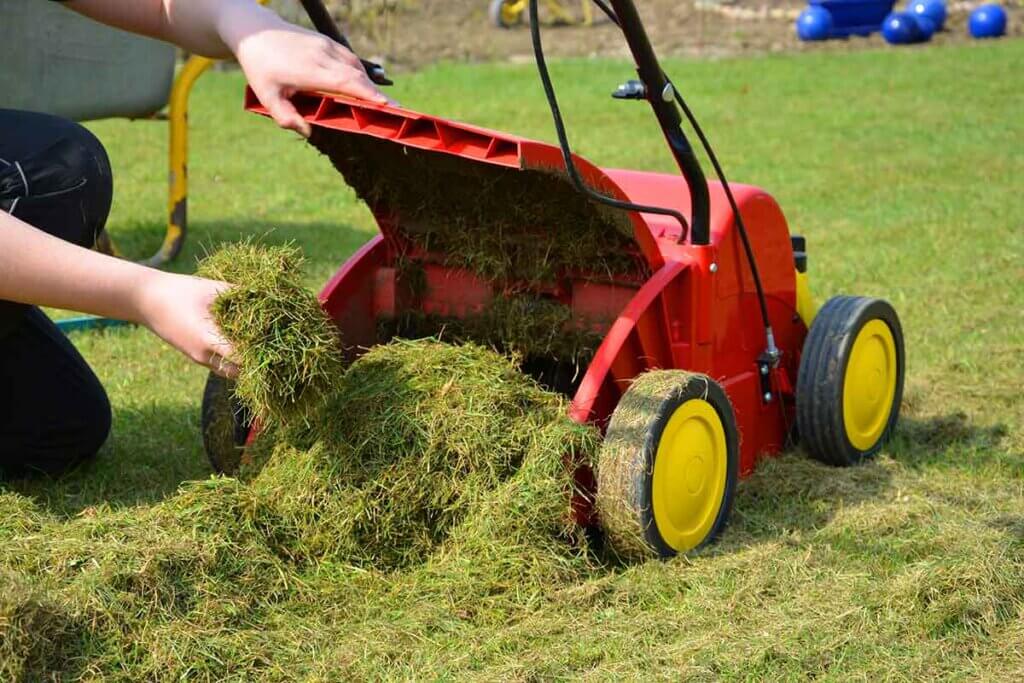
A scarifier can be started easily and safely via a bow switch – also called a dead man’s switch. This switch-on lock ensures that the blades can only rotate during use. The unit can only be switched on in two steps, for example when a handle is pressed up at the same time. If this handle is released, the power supply is interrupted and a safety shut-off occurs.
A height-adjustable handle not only ensures an ergonomic and back-friendly posture. When the work is done, the unit can be stored in a much more space-saving way.
It is particularly useful if a replaceable aeration roller with spring tines is included in the scope of delivery. The spring roller combs moss, cuttings and other unwanted growth out of the lawn. The scarifier thus also takes on the task of a lawn aerator or rake.
Since a scarifier is not an everyday device, it is advisable to read the operating instructions carefully and keep them. An instruction manual must contain all the important information and convey it in a comprehensible way. By studying the instruction manual thoroughly, accidents and damage to the machine or the lawn can be prevented.
How much does a scarifier cost?
Unsurprisingly, manual scarifiers are the cheapest. Models that do the job reliably are available for as little as about 20 euros. If you want more comfort, you only have to shell out a little more money. The cheapest electric scarifiers start at 60 euros. Whether this is a sensible purchase should be reconsidered. In the worst case, cheap machines will ruin the lawn. Good and robust models are available in the medium price segment from 100 euros. Hobby gardeners can spend up to 250 euros for a premium scarifier.
Tips for use
Before scarifying, a few questions need to be answered. The soil must be loosened at a suitable time and the lawn must be in a suitable condition. To ensure that the lawn grows beautifully again after scarifying, pre- and post-treatments are recommended.
When is the right time?
It is best to scarify the lawn at the beginning of the growth phase in spring. Then not only blades of grass grow, but also plants that are not wanted on the lawn. Scarifying before then is not worthwhile because the ground may still be frozen. The weather should always be stable enough so that it cannot freeze again after the lawn treatment.
Pushing the scarifier over a wet lawn is not a good idea. Damp soil inhibits the rotation of the blade roller. This resistance can damage the machine. It is also not good for the lawn, as it can turn into a muddy landscape. So after a rainy day, you have to wait.
If the summer was sunny and humid, you can scarify again in late August or early September. These conditions also favour the growth of mosses and weeds. If, on the other hand, the summer was hot and dry, scarifying the lawn will damage it. By scarifying the surface, it releases even more moisture. The soil therefore becomes hard and the grass yellow.
Test run on new lawn
Freshly sown lawns should not be scarified for the first two to three years. This treatment is only advisable when the grass blades are already thick. When the time comes, a trial run with a working depth of two millimetres is recommended. Scarify one lane and check the amount of clippings combed out. If the result is not satisfactory, the cutting depth can be increased.
Instructions for scarifying
As a pre-treatment, the lawn can be fertilised three to four weeks before scarifying. In this way, the lawn is optimally supplied with nutrients and strengthened overall. This is advantageous because scarifying is a strain on the lawn. Fertilising beforehand is the best way to prepare the lawn for this stress. After scarifying, the lawn can continue to grow vigorously. Fertilisation is particularly advisable for very dense lawns or if it has been more than two years since the last scarifying. When the lawn is prepared and the weather is fine, proceed step by step:
- Before scarifying, cut the lawn down to two to four centimetres.
- Set the scarifier’s scoring depth to two to three millimetres.
- Push the machine into the down position and switch it on.
- Drive down the lawn in lanes.
- Start on the outside and work your way in.
- Change direction at the end of each lane.
- If the lawn is very matted, it can be scarified twice in succession.
- Proceed at right angles to the lawn that has already been worked on.
Aftercare
The lawn area that has been stressed by scarifying can be watered well directly after scarifying. By loosening the soil, the water can easily reach the roots. Stop watering as soon as the soil has become saturated. However, make sure that no standing water forms on the grass.
After about a week, it is a good idea to fertilise the lawn again. Scarifying removes nutrients from the soil, which can be supplied to it in this way. These penetrate much better into the loosened soil after cultivation.
Where there used to be moss and weeds, bare patches sometimes appear after scarifying. New grass should be sown here before unwanted plants spread again. Moss, weeds and felt make it difficult for grass seeds to sprout. Therefore, after scarifying, optimal conditions are provided for new sowing. The seeds are scattered lengthwise and crosswise and lightly worked in with a rake. During the next four weeks, it is advisable to keep the newly sown area slightly moist at all times.
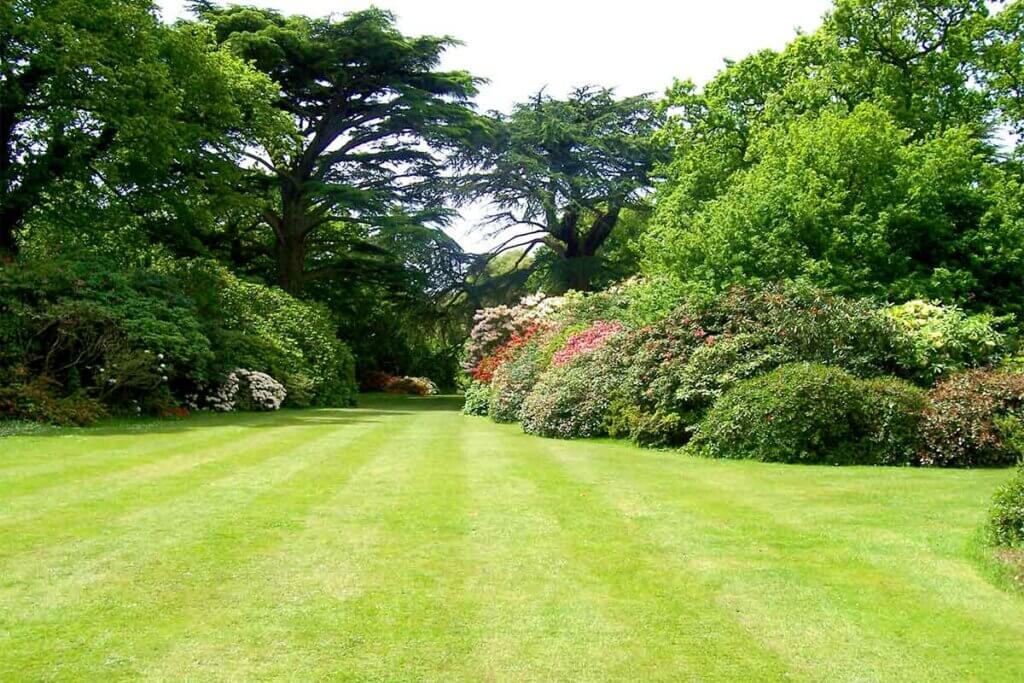
Sanding rounds off lawn care. What works on golf courses and football pitches is also suitable for the home garden. In compacted soil, lawn sand creates drainage and thus acts as protection against waterlogging. But not just any sand is suitable for this treatment. The sand used should be very fine, with a grain size of 0 to a maximum of 2 millimetres. Washed quartz sand with a low lime content is well suited.
After scarifying, the lawn needs some rest and should not be overworked. If possible, walk on the lawn as little as possible for two to three weeks. Garden parties or football matches are not advisable shortly after scarifying.

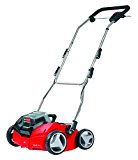
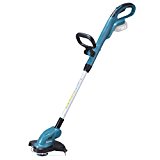
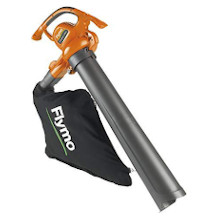
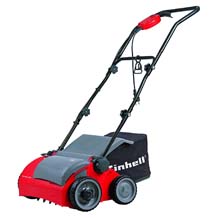
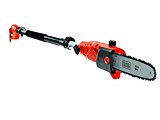
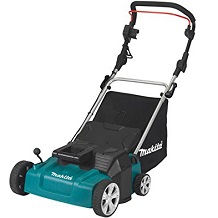
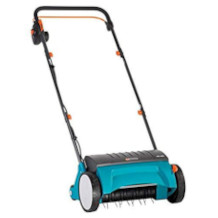
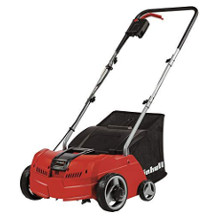
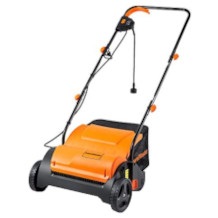
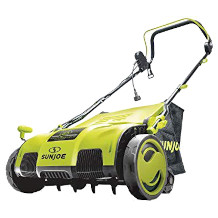
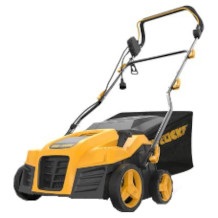
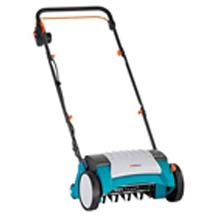

 321 reviews
321 reviews

